Exploring Greater & Lesser Rann of Kutch
Vast barren land as far as the eye can see – this will be the first impression of anyone on reaching the Greater Rann of Kutch (GRK) in Gujrat, Kutch. As we have became accustomed to the city life, we are not used to seeing open spaces spread for miles together. Anyone visiting this barren land will feel that there is nothing here, but just small tufts of grass and bushes here and there. So one may get an impression that no kind of life can survive here. But contrary to this impression, in this desert landscape we can find lot of species of mammals, birds and reptiles which are native to this terrain. And come winter months one can find lot of migratory birds as well.
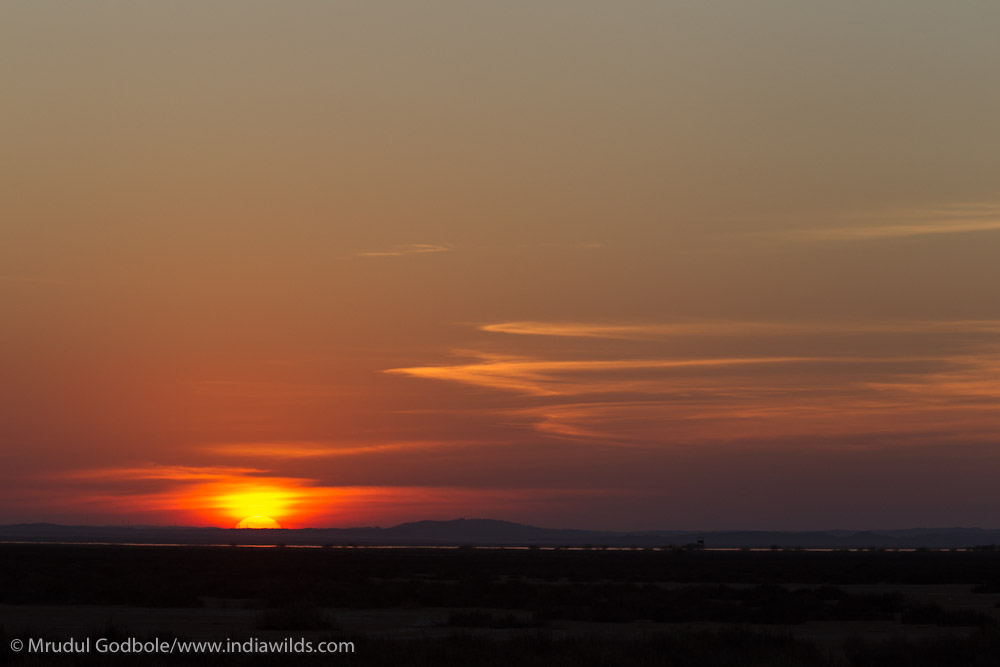
Sunset at Greater Rann of Kutch (GRK)
I had been planning for a long time to visit this western border of India, but getting a nice experience of this place would need a longer trip. So one had to get a considerable amount of leaves accumulated before one can actually start planning. This opportunity came in Dec 2012 when Sabyasachi left MAIT to follow his passion so he had ample time in his hands for a filming trip. I applied for 3 weeks leave from Dec 13th and my flight bookings from Bangalore to Delhi and back were done. We decided to drive all the way from Delhi to GRK and back, that is a total of around 2700 km.
In the trip we were going to cover GRK and on the return journey stop at LRK for a week.
I took the early morning 6 am flight from Bangalore to Delhi. On landing at 9 am, we immediately were on our way to GRK. We had to cover a total of 1400 km.
The first part of the journey was to reach Ahmedabad (945 km). So while trying to take a short cut to avoid traffic we took a wrong turn in Delhi and spent a lot of time negotiating the traffic as couple of roads were blocked. It was a relief when we finally took to the National Highway NH 8. The highway at that time was under construction in lot of places till Jaipur. It was post noon till we crossed Jaipur, stopping on the way only for lunch. After Jaipur we were able to gain speed and our target for the day was to reach Udaipur i.e cover around 670 Kms. As it was getting dark before reaching Udiapur, so we stopped at one of the hotels on the way roughly 100 kms before Udaipur.
It is always a nice feeling when we go on a drive. I play the role of a navigator reading maps and road signs and Sabyasachi drives. The MapMyIndia device in those days used to lose its way at times. Those were the days before google maps became prevalent. I had to be careful as once in 2008, I had become absent minded while talking and we drove 40 kms ahead instead of taking a U turn. Now we laugh over that incident but driving extra 80 kilometers that day had really derailed our plans. Whenever we see something nice, we just stop to get a good view. So we talk and really enjoy our drives. Else only two of us driving thousands of kilometers would not have been fun. We have done these kinds of journeys to North, South, East, West as well as to central India in all kinds of terrain. It is really fun. I digress.
Next day we started around 7 am after having a heavy breakfast. Ahmedabad was around 450 km. We reached Ahmedabad around 6pm due to the heavy traffic after getting closer to the city. GRK is around 400 km from Ahmedabad. It had started drizzling. We somehow lost our way in the dark and had to take a detour. So we decided to just move to the outskirts of Ahmedabad and stay in some resort for the night and start early next day. We rarely drive in the night as he considers it to be unsafe. Somehow we found a 3 star hotel. However, we were surprised when they asked for our thumb impressions. Are we criminals? This was the first time ever we had to give thumb imprints in a hotel.
Next day we started early from Ahmedabad to Bhuj in the express highway and we were able to reach Bhuj by 12 pm. The landscape changes a lot once you start approaching Bhuj. You can see salt pans on both the sides of the highway. Also big areas under wind mills can be seen. Once you cross Bhuj, you mostly see barren land with a few houses here and there. Mostly flat roof mud houses. The men wearing kurtas and pyjamas can be seen tending herds of cattle.We saw jungle cat and a mongoose road kill. That saddened our heart. Even in the empty roads we were driving only at 70kmph to avoid hitting any such small animal. We had decided to visit a place called Kalo Dungar before visiting other parts of GRK.
Kala Dungar
Kala Dungar or Black Hill is the highest point in Kutch, Gujarat, India, at 462 m. It is located at 97 km from Bhuj and 25 km from nearest town of Khavda. Kala Dungur is probably the only place in Kutch from where a panoramic view of the Great Rann of Kutch is possible. Since it is located very near to the Pakistan border, there is an Army post at the top; beyond here, only military personnel are allowed.
The Kala Dungar is also famous for a 400 year old Dattatreya temple. Legend says that when Dattatreya walked on the earth, he stopped at the Black Hills and found a band of starving jackals. Being a god, he offered them his body to eat and as they ate, his body continually regenerated itself. Because of this, for the last four centuries, every evening the priest at the temple prepare a batch of prasad, cooked rice (called Khichadi), that is fed to the jackals after the evening aarti that is around 6 pm.
We wanted to witness this unique practice and so had planned to stay in the night at the temple. By the time we reached it was nearly 5 pm. We managed to get some accommodation after talking with the temple manager. Since we had to be ready to film and photograph the unique practice we immediately unpacked and readied our equipment. After the aarti was over, the priest got the big plate of the prasad and set it on the edge of the mountain on a raised platform. After doing so he beat on a empty plate a couple of times as if ringing a bell.
Just as the sun set, we could see some jackals slowly coming out from behind the mountain towards the rice plate. As it got dark we could see atleast 10-15 jackals feeding on the rice. After it got quite dark and other people had left, some porcupines also came to the spot to finish the left overs.
It was my first experience to watch porcupines feeding. Many years earlier in K Gudi, in 2007 when we were driving from KGudi to BR Hills in the night, we had seen a porcupine crossing the road. The sighting was for hardly a minute. Here we could see 4-5 big porcupines come quite close and feed on the rice.It was totally dark and we stayed on to see what other species we could spot. After 8, the rice was over and on seeing no other animals coming we decided to pack up.
The night was cold and it was nearly full moon, things were quite clear in the moonlight. We saw a few porcupines feeding on the food thrown near the temple. They were cleaning the plastic cups and plates. It was sad to see that such a remote place had such a huge amount of waste, especially plastic cups and plates. As they can be used and thrown and no need to clean. There were no signs to keep the place clean and no waste management done. Due to unavailability of natural food, the wildlife was reduced to scavenge on the plastic cups and plates and feed.
We got up early in the morning around 5 am to take some photographs of the sunrise. We went to the highest point and waited. As the sun came up, we saw a breath taking view of the Greater Rann of Kutch. The early morning fresh air hitting us we could see the entire Rann spread infront as far as the eye could see. It was a moment where you feel that you are just a small spot in the whole scheme of things.
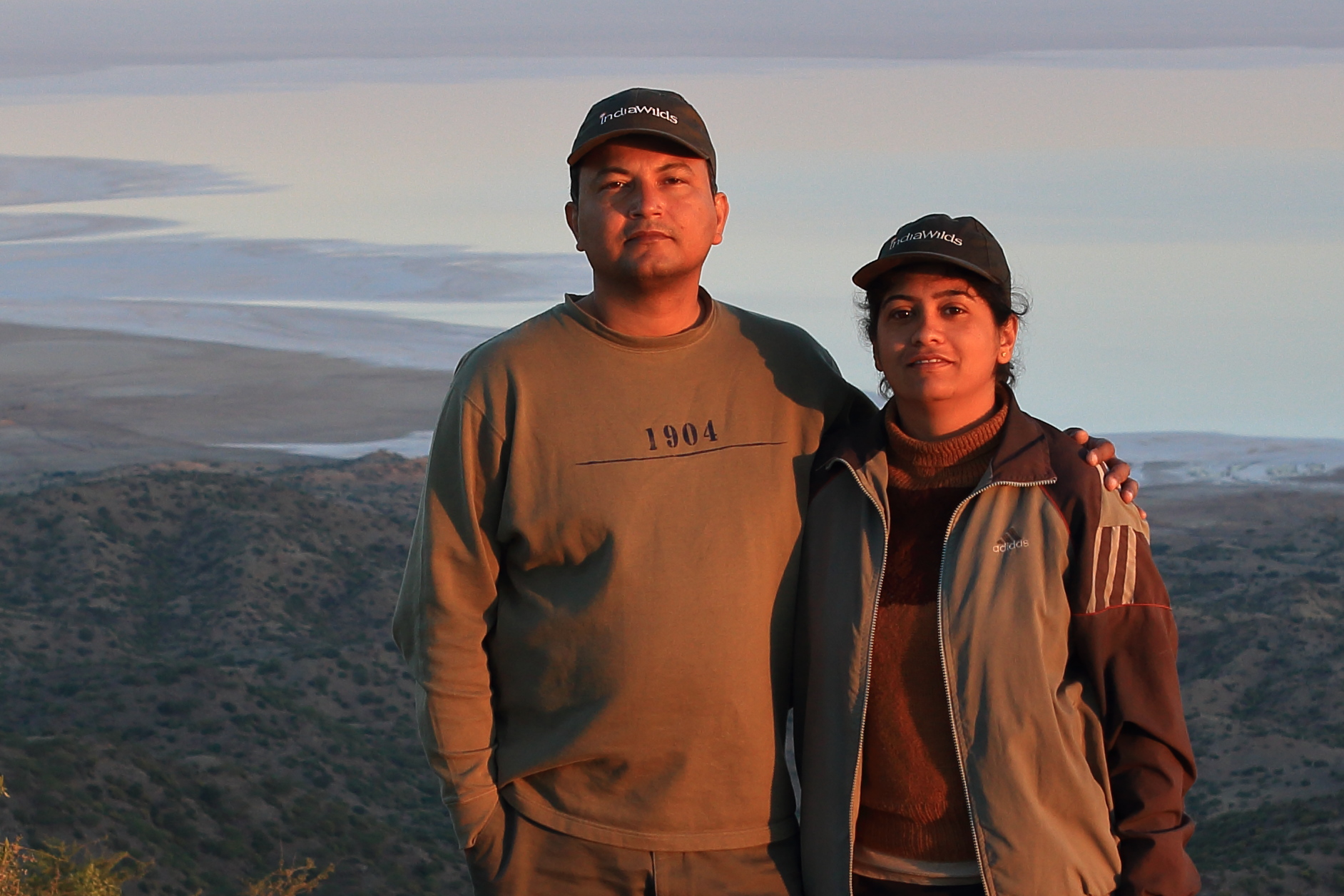
Later we left Kala Dungar and reached Nakshatrana in GRK. There are number of grasslands which one should experience. We hired a guide to show us the way as in the vast grasslands, every direction you look, the scrub vegetation is the same and you can easily lose your bearings. Next day we started early around 5am and went to Fulay and met our guide.
Banni Grasslands
The first sighting of the day was the ‘Grey Hypocolius’ or simply ‘Hypocolius’ (Hypocolius ampelinus). It is a small passerine bird species. The Grey Hypocolius is a slim bird with a long tail, slight crest and thick, short hook-tipped bill. They are mainly a uniform grey or brownish-grey colour, with males having a black triangular mask around the eyes. They have white-tipped black primary wing feathers and a black terminal band on the tail. Adults are about 1921 cm in length. After we got some satisfactory photographs of Hypocolius we drove on in search of other birds.
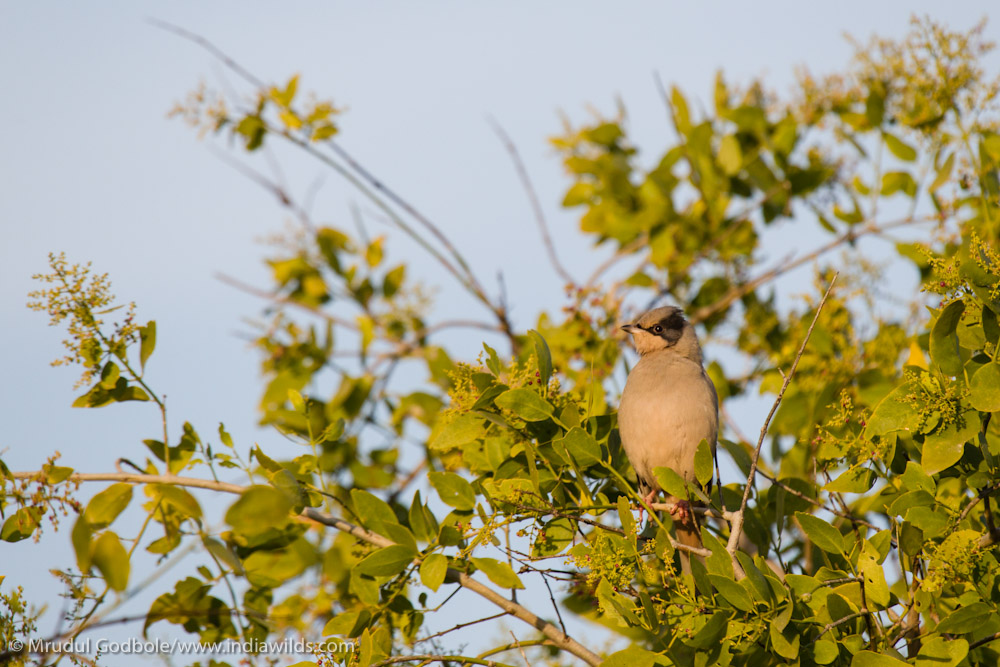
Grey Hypocolius
It was my first time in a habitat like GRK and so I was quite enthralled to see this amazing landscape. Vast expanse of land as long as the eye can see. Some small bushes and shrubs were the only vegetation seen. Large areas have been colonized by the non-indigenious plant called Prosopis juliflora, which is locally knows as “Gando baawal” (mad weed) for its almost manic ability to spread. The species is now used to make charcoal. Lot of fires can be seen around the villages to burn down these trees and make charcoal. Unrestrained burning causes harm to the environment.
As the day progressed, it started to become hot. There is not much use in photographing when the light is harsh, so we decided to take rest near Chari dhand.
Our guide pointed to a herd of camels resting near a water hole by the side of some trees. So we decided to go and check. As we approached the place, we saw 2 small boys around 10-12 years age managing the big herd. Our guide asked us if we could like to have tea. With no tea stall or a shop of any kind in sight I asked where? He said the boys can make us tea with camel milk. I was surprised to hear that, but said yes.
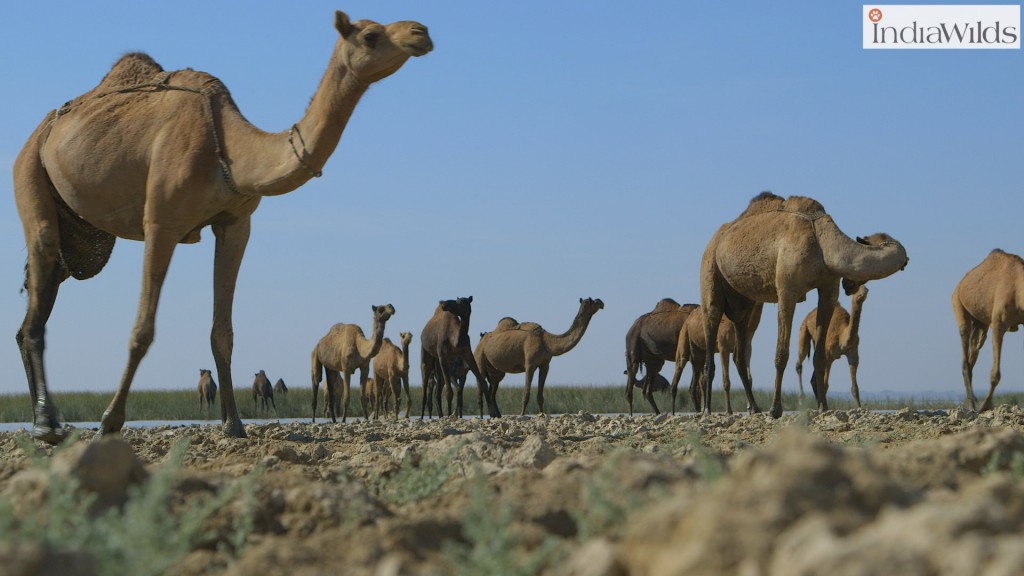
Camel Herd in GRK
The elder one took out a small vessel from his small bag and cleaned it with the sand. Then he gave it to the younger one, who went to one of the camels in the herd and milked her. He got the fresh milk and the elder collected some dried sticks and made a small fire and kept the milk on it to heat. He added some tea leaves from his bag and in 2 mins tea was ready. This was the first time in my life that I had tea made from camel milk. It tested wonderful. I was amazed to see these two small boys on their own in the middle of this desert. When asked what they eat the whole day, our guide replied they only have camel’s milk the whole day, as it is very good to have in this hot weather and very heavy. One will not feel hungry after having camel’s milk. These are poor folks. The entire family is engaged in raising camels of some rich people. We offered them some money through the guide and they gladly accepted. We spent a few days moving around with these shepherds simply drinking freshly milked raw camel milk for lunch on some days to understand their lifestyle.
There are a few wetlands in this desert ecosystem. So we sighted lot of birds like egrets, varieties of cranes, waterfowls and steppe eagles. One of the first mammals we sighted was an Indian Fox (Vulpes bengalensis)which immediately bolted on the sight of the car. We tried to follow it slowly at a respectable distance. In the next few days we could come much close to them. Silence, slow approach and patience is the key.
Early next day we were back in Chari Dhand by 6am to meet our guide. As we started to go around,our guide spotted a fox resting in some grass. With its head down it was impossible to spot him from the distance. We slowed our car and tried to get close, as the sun was rising maybe due to the noise of the car, the fox got up. We immediately took our positions and patiently waited. We managed to get a few photographs.

Indian Fox
If it doesn’t perceive a threat then it will not run away. The fox saw us and then again got down to sleep. After taking few more photographs we decided to move on.
On sighting a few dens of desert cat, we decided to park and wait. We spent lot of time there for days but it didn’t result in any sighting. These desert cats dig up elaborate dens with many approaches. So if some one tries to catch it from one entrance then the desert cat can exit from another entrance in the opposite direction.
One day as the sun was setting we came across a carcass of a young camel. It seemed as if it was freshly thrown there with the skin taken off. We thought of waiting near it to see what happens. Soon few feral dogs came to the spot and started to feed on it. As the sun set, a few jackal’s too came to the spot, but due to the majority of the feral dogs, they were not able to even get closer to the carcass. A big wild boar with a few piglets came and drove away the feral dogs and started feeding on the carcass. The jackals losing out to the feral dogs hung around calling and looking for a chance to feed. We managed to film the scene, which can be seen in the video below –
The next few days the guide was not available and we drove alone, losing and finding our way many times. Once we had frozen upon the places we want to see, it was a game of patience. We waiting for a long time to make the animals feel comfortable with us. At times the place was a bit disorienting so we were a bit nervous but overall the trip ended well and we started our journey back from Greater Rann of Kutch. We then moved to LRK for a week.
Little Rann of Kutch (LRK)
By the time we reached Little Rann of Kutch (LRK) and checked into the hotel it was 3 pm and time for the afternoon safari. We decided to hire the gypsy instead of taking permission and driving our Tata Safari SUV. Without wasting any time we got ready and boarded the gypsy. Unlike GRK, we found that LRK being close to Ahmedabad has lot of villages. A lot more tourists visit this place. I was surprised to find that the villages were incredibly dirty with plastics and other waste items littered all around. There was open defecation. We were embarrassed when foreigners asked why there is so much open defecation here. Due to this we don’t get the same feeling of vastness of nature as in the Greater Rann of Kutch (GRK). We found that there are lot of salt pan activities going inside LRK. There are huts of people working in the salt pan around some place. It was a very harsh way of harvesting salt without much of modern equipment. One can realize that these people are poor and suffering a lot to continue with this business. I guess middlemen may be getting the main benefits from their hard work. With our huge population more and more people are trying to fight against nature to eke out a living. Rann is a vast place but slowly we the humans are chipping away at its wilderness bit by bit. I wonder why am I born in this era? How much better it would have been for our parents generation when our wild lands were more pristine. While thinking all these we moved on in search of wildlife.
We drove ahead and in just a few minutes sighted a herd of Wild Ass (Equus hemionus khur). The coat is usually sandy, but varies from reddish grey, fawn, to pale chestnut. The animal possesses an erect, dark mane which runs from the back of the head and along the neck. The mane is then followed by a dark brown stripe running along the back, to the root of the tail.
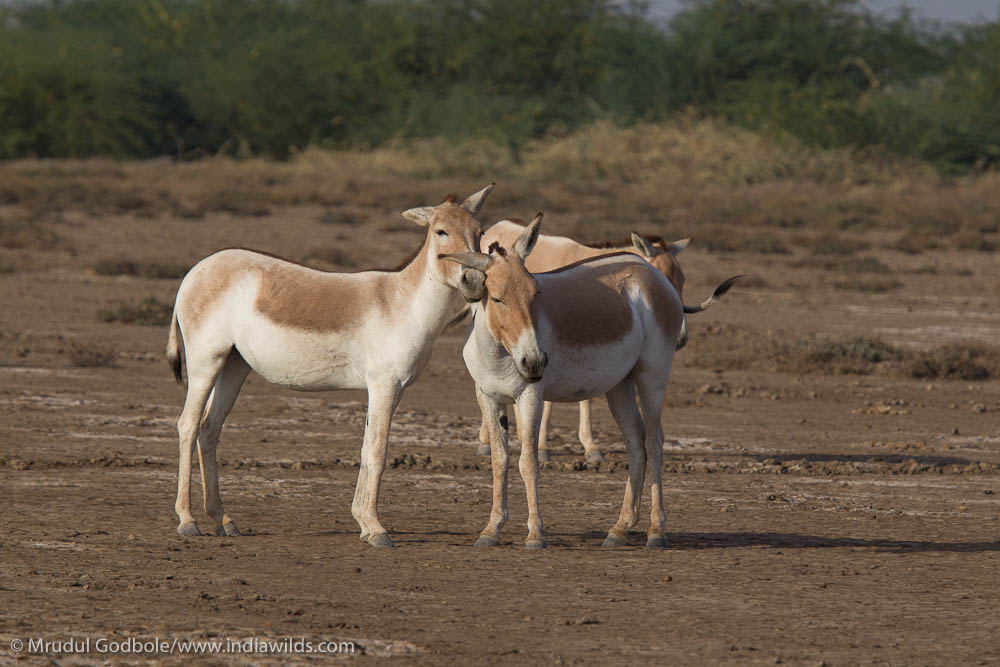
Wild Ass at LRK
We had a nice sighting of a young one suckling it’s mother. That love and warmth between mother and child made us feel relaxed and happy. We got a few more photographs of the herd and then we moved on.
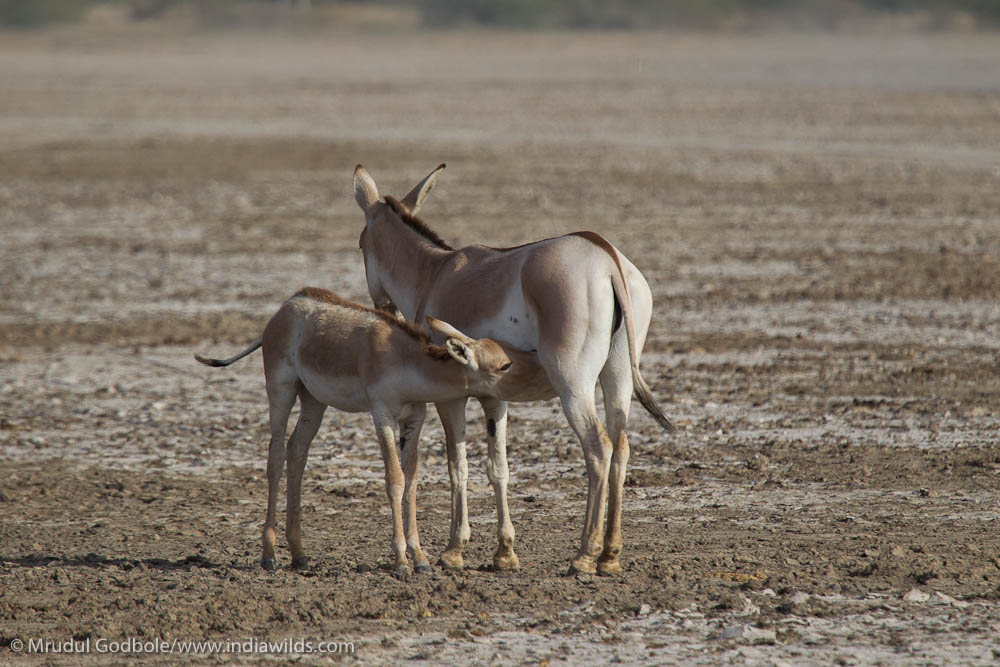
Calf suckling
The driver/guide knew the place well and knew where which bird or animal is usually sighted. We sighted the short-eared owl sitting in a small shrub, and could click some nice closeups. The camouflage is so good that it is difficult to notice the bird. It remains so still that only when it closes its eye lids one can see some movement.
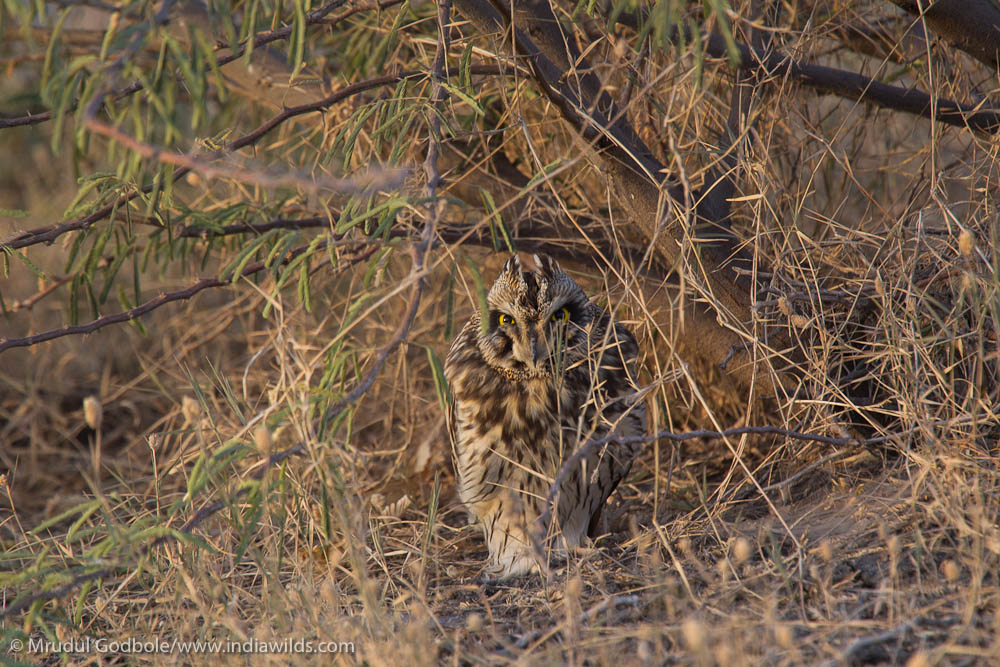
Short-eared Owl
As the evening approached we saw a pair of desert foxes chasing a prey. It was my first sighting of a desert fox (Vulpes vulpes pusilla), and to see a pair chasing a prey was a rare sighting. I got a few images but the light being low was not fully satisfied with the result.
The colour on the back of the desert fox varies from brownish yellow to rusty red with slight admixture of white, while the flanks are whitish or greyish. The outer surface of the limbs are iron-grey or rufous, while the inner side of the forelegs and the whole front of the hind legs are white. The face is rufous, with dark markings around the eyes. The underparts are slaty in hue. The chin and the centre of the chest is white.Most of the tail’s hairs are black, and may form a dark ring at the end of the tail. The tip is white.
Early next morning we returned and went straight to the place where we had sighted the desert fox. But after looking around for a long time we couldn’t sight them and returned back to the hotel. We sighted a couple of birds like Steppe eagle, Siberian Stone chat and Lesser and Greater Flamingos.
The evening safari proved lucky, and we saw the same pair of desert foxes on the prowl. After following them, luckily we got the male approaching from the other side. We stopped the gypsy and waited. He was inquisitive and came quite close. It was a very amazing moment and I got the photograph I was waiting for, an head on of the desert fox coming towards us.
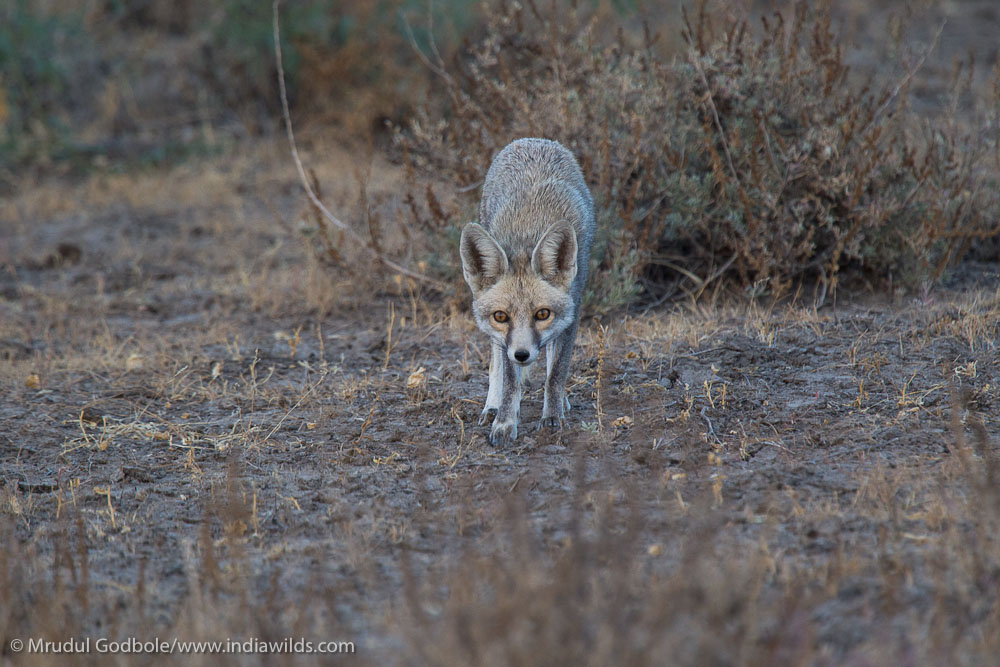
Desert Fox
The next morning was the last day of the year as well as our last safari in LRK. We went to small lake outside the forest boundaries where there were huge number of flamingos feeding. As the sun rose, the light was perfect and we waited patiently for the flamingos to come closer to us. It is a pleasure to watch these tall birds, with their head low, and the beak in water feeding as they walkthrough the shallow waters. The light pink to reddish color plumage make them look very dainty.
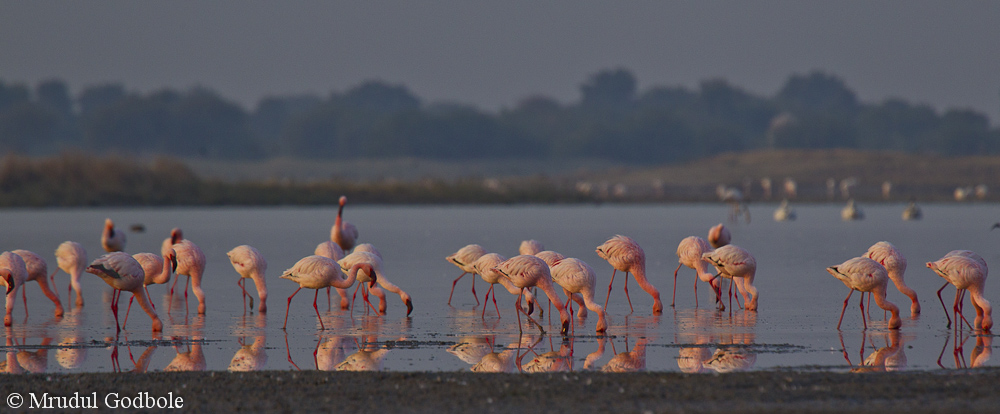
Flamingos
We returned and packed our stuff to leave. We started our long return drive back to Delhi.
The entire journey of Kutch had been quite momentous. To see and experience such a raw wilderness with its desert landscape, grasslands and wetlands and the animals and birds which form an integral part of it made our visit truly memorable.
Edit: I discovered that Mrudul had privately published this article as the administrator of the site and it was not visible to public. Perhaps she had intended to make it public later. So publishing it now in her name.
- Exploring Greater and Lesser Rann of Kutch - 11 November,2022
- A Visit to Eravikulam: NeelaKurinji landscape - 10 October,2018


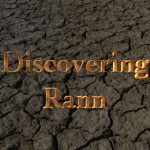

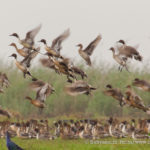
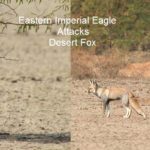
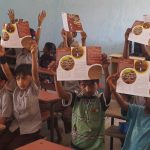
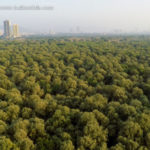



Leave a Reply